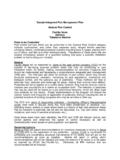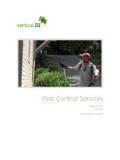Transcription of Sample Integrated Pest Management (IPM) Bid …
1 Sample . Integrated PEST Management (IPM). BID SPECIFICAT. CONTRACT FOR COMMERCIAL PEST control services . General Pest & Rodent control 1. GENERAL. a. Description of Service This contract is part of a comprehensive Integrated Pest Management (IPM). program for the buildings and other areas specified herein. The goal of IPM is to deliver effective pest control while at the same time reducing the volume and toxicity of pesticides used and human and environmental exposure to pesticides. IPM is a process for achieving long term, environmentally sound pest control through the use of a wide variety of technological and Management practices. control techniques in an IPM program include a combination of pest monitoring, good sanitation practices, education, appropriate solid waste Management , building maintenance, alternative physical, mechanical, and biological pest control , and the use of pesticides when warranted according to a predetermined hierarchy of pest Management choices, formulations, and application techniques, which will minimize the exposure and potential risk to people and the environment.
2 The contractor shall furnish all supervision, labor, materials and equipment necessary to accomplish the surveillance, trapping, and pesticide application components of the IPM program. The Contractor shall also provide detailed, site- specific recommendations for structural and procedural modifications necessary to achieve pest prevention. b. Requirements for Bidding In order for a company to qualify for the bidding process, it must meet the following requirements: (1) Possess a valid commercial pesticide application business certificate of registration from the Connecticut Department of Environmental Protection;. (2) Employ a minimum of one certified commercial supervisory applicator for every five certified commercial operational applicators employed;. (3) Provide proof of appropriate insurance;. (4) Provide three references attesting to the company's knowledge or experience in the field of IPM. c. Pests Included and Excluded The Contractor shall adequately suppress indoor populations of rats, mice, cockroaches, ants including carpenter ants as occasional invaders, winged termite swarmers emerging indoors, incidental/occasional invaders entering from out-of-doors, and flies and other arthropod pests not specifically excluded from the contract.
3 Populations of these pests that are located immediately outside of the specified buildings and pose a possible infestation problem to the specified buildings are included. Populations of the following pests will be considered special services , separate from the specifications of this contract: Birds, bats, snakes and all other vertebrates other than commensal rodents;. Termites, carpenter ants nesting within structures and other wood-destroying organisms;. Mosquitoes and other free flying insects originating out of doors;. Pests that primarily feed on outdoor vegetation;. Fleas and ticks. d. Initial Inspection The Contractor shall conduct a thorough, initial inspection of each building or site within the agreed upon number of working days after the effective date of the contract. The purpose of the initial inspection is for the Contractor to identify problem areas and any equipment, structural features, or Management practices that are contributing to pest infestations.
4 The initial inspection shall be conducted by a certified commercial supervisory applicator employed by the Contractor. Access to building space shall be coordinated with the Contracting Officer's Representative (COR). The COR will inform the Contractor of any restrictions or areas requiring special scheduling. Ideally, the COR should have oversight of custodial staff to ensure that sanitation practices and building maintenance procedures associated with proper pest control are accomplished, and should interact with all facility staff 1. members to ensure that pest sightings and other pest control related items are promptly brought to the attention of the Contractor. e. Pest control Plan Prior to initiation of service, the Contractor shall submit to the COR a Pest control Plan for each building or site within the agreed upon number of working days following the initial inspection. Upon receipt of the Pest control Plan, the COR will render a decision regarding its acceptability within an agreed upon number of working days.
5 The Contractor shall be on site to initiate service within an agreed upon number of working days following notice of approval. If aspects of the Pest control Plan are incomplete or disapproved, the Contractor shall have an agreed upon number of working days to submit revisions. The Pest control Plan shall consist of five parts: (1) Proposed methods for control , including labels and Material Safety Data sheets (MSDS sheets) for all pesticides to be used. A list of types of rodent bait boxes, insect and rodent trapping devices, pest monitoring devices, and any other control devices or equipment should also be included;. (2) A proposed pest population level referred to as a predetermined tolerance threshold, if thresholds exist for the targeted pest;. (3) A service schedule for each building or site;. (4) A description of any structural or operational changes that would facilitate the pest control effort;. (5) A copy of the Commercial Pesticide Applicator Certificate for every Contractor's representative who will be performing on-site service under contract.
6 It shall be the Contractor's responsibility to carry out work according to the approved Pest control Plan for each building or site. The Contractor shall receive the concurrence of the COR prior to implementing any subsequent changes to the approved Pest control Plan, including additions or replacements to the pesticide list and to on-site service personnel. f. Pesticide Application The Contractor shall not apply any pesticide product that has not been included in the Pest control Plan or approved in writing by the COR. The COR will make a timely decision on any matter that requires a written approval. 2. Pesticide application shall be according to need and not by schedule. As a general rule, application of pesticides in any area inside or outside the premises shall not occur unless visual inspections or monitoring devices indicate the presence of pests in that specific area. Preventive pesticide treatments of areas determined to be at high risk for infestation by insects or rodents, through inspection at the onset of the program or as part of a maintenance program, are acceptable.
7 These applications must be conducted in accordance with the pesticide use hierarchy found in section 2. INSECT control of this document. Written approval must be granted by the COR prior to any preventive pesticide application. The Contractor shall not store any pesticide product on the property of the contractee. g. Structural/Procedural Recommendations Structural modifications for pest control , including the application of caulk and other sealing materials will not be the responsibility of the Contractor. However, throughout the life of this contract, the Contractor shall be responsible for notifying the COR in writing about any structural, sanitary, or procedural modifications deemed necessary to eliminate pest food, water, harborage, or access. h. Record Keeping The Contractor shall be responsible for maintaining a pest control logbook or file for each building or site specified in this contract. These records shall be kept on the property of the contractee and maintained on each visit by the Contractor.
8 Each logbook or file shall contain at least the following items: (1) A copy of the Pest control Plan for the building or site, including labels and MSDS sheets for all pesticides used in the building, and the Contractor's service schedule for the building;. (2) The Pest control Work and Inspection Report forms will be supplied to the Contractor by the COR, and will be used to advise the Contractor of routine service requests and to document the performance of all work, including emergency work. This includes all the information on pesticide applications required by the Connecticut Pesticide control Act. Upon completion of a service visit to the building, the Contractor's representative performing the service shall complete, sign and date the form, and return it to the logbook or file on the same or succeeding day of the services rendered. 3. i. Contractor Personnel Throughout the life of this contract, all Contractor personnel providing on-site pest control service must meet state requirements for training and certification as Commercial Pesticide Applicators.
9 Uncertified individuals working under the supervision of a Certified Applicator will not be permitted to provide service under the terms of this contract. j. Manner and Time to Conduct Service The Contractor shall perform routine pest control services that do not adversely affect occupant health or productivity during the regular hours of operation in the buildings. No sprays or dusts may be applied when the immediate area to be treated is occupied. When it is necessary to perform work outside of the regularly scheduled hours set forth in the Pest control Plan, the Contractor shall notify the COR at least one day in advance. The Contractor shall observe all safety precautions throughout the performance of this contract. Certain areas within some buildings may require special instructions for persons entering the building. Any restrictions associated with these special areas will be explained by the COR. The Contractor shall adhere to these restrictions and incorporate them into the Pest control Plan for the specific building or site.
10 All Contractor personnel working in or around buildings designated under this contract shall wear distinctive uniform clothing. The Contractor shall determine and provide additional personal protection equipment required for the safe performance of work. Protective clothing, equipment, and devices shall, as a minimum, conform to Occupational Safety and Health Administration (OSHA). standards for the products being used. k. Special Requests and Emergency Service On occasion, the COR may request that the Contractor perform corrective, special, or emergency service (s) that are beyond routine service requests. The Contractor shall respond to these exceptional circumstances and complete the necessary work within one (1) working day after receipt of the request. In the event that such services cannot be completed within one working day, the Contractor shall immediately notify the COR and indicate an anticipated completion date. 2. INSECT control .















